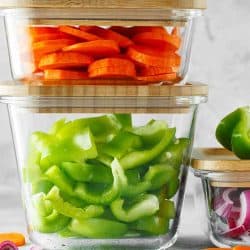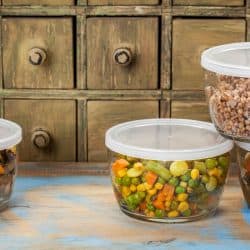Pyrex glassware is one of the most popular brands for storing, forgetting, cooking, and baking food. The convenience it offers has made it a staple in many American households for the past few decades. But can you put the Pyrex in the freezer? We've researched Pyrex to find the answer to this question.
Yes, you can place Pyrex in the freezer without ruining it. Pyrex is both heat-resistant and freezer-safe. It is made to withstand temperatures from -40 degrees to 500 degrees Fahrenheit. However, the glass has safety precautions to ensure that it is used properly and does not damage while in use.
Pyrex is one of the most versatile and long-lasting glassware brands that you can purchase today. Not only can you use it for a variety of meal preparation and cooking applications, but you can also use it for storage as well such, as in the freezer. Let's discuss some of the safety precautions to heed when using Pyrex for multiple applications.

How To Use Pyrex Safely
Pyrex is safe for storage in the freezer, and the Pyrex website states that the glassware can go directly from the freezer and to an oven temperature of around 300 degrees. However, according to several consumers and cooking experts, this isn't entirely true--at least not all of the time. Reports have shown that Pyrex can be prone to shattering when placed in opposing temperatures back to back. This is likely due to thermal shock.
When using Pyrex or any other type of glass base cookware and bakeware, it's always best to avoid extreme and immediate temperature changes, meaning that you shouldn't place cold glassware directly in a hot oven or hot glassware directly in the freezer. The sudden temperature change can cause the glassware to break and shatter.
This can be a hard thing to resist for sure. For example, if you have a frozen glass plate of lasagna that you are looking to heat for Tuesday night's meal, you shouldn't take the glassware directly from the freezer and place it inside the oven.
Instead, let the glassware sit on the counter at room temperature for about 10 to 15 minutes or until the oven preheats. This will give the glassware time to warm up and adjust to the extreme temperature change once placed in the oven.
You can also consider purchasing a potholder, cooling rack, or dry cloth to set the glassware on while it cools down. Also, be sure not to refrigerate, wash, or freeze glassware that has just been removed from the oven. Give it time to cool down and adjust to new temperatures.
How do you defrost frozen Pyrex?
The best way to defrost Pyrex glassware is to allow the glassware to warm up a bit before placing it in the oven or the microwave. The glassware should be more on the cool side than the cold side, as this can prevent it from experiencing thermal shock.
You can also replace the glass in the refrigerator to help it defrost as well. Another way to defrost Pyrex glassware is to place it in a dish sink of warm water about an inch high. Allow the glassware to sit in the warm water for about 5 to 10 minutes until it is cool to the touch.
Is Pyrex unbreakable?
While Pyrex is extremely durable and way stronger than ordinary glass due to design characteristics and a tampering process during its creation, it's not completely unbreakable. You may have heard Pyrex glassware shattering stories when placed on hot stoves after being removed from freezers. The fact of the matter is Pyrex is still glass.
If too much stress is placed on the glass, the structure will not hold up well, resulting in a shattering effect. The best way to avoid this is to be mindful of how you move the glassware from one temperature to another. Avoid extreme temperature changes and never place glassware directly on a hot stovetop, hot plate, or broiler, as it can cause the glass to shatter as well.
Safety Tips to Keep Pyrex From Shattering
Pyrex products come with warnings when you purchase them. These warnings should be noted, as they can keep you from experiencing issues with your glassware, such as shattering and breaking. However, there are other precautions that you should take when working with Pyrex, many of which have been noted by everyday consumers who've experienced this. Let's take a look at the most common ones.
Do not set hot glass dishes directly on the stovetop
While the eyes on your stovetop and heat-resistant, and even though Pyrex can withstand temperatures up to 400 degrees or more, it doesn't mean that the glass should be placed directly on a cool surface. Doing so can cause shattering in a matter of seconds. Instead, take a hot pad or silicone rest and then put it on the stove. You can also consider a wooden board or a layered dish towel.
Do not attempt to cook a dry dish in Pyrex
The Pyrex site state directions explicitly add a small amount of liquid to the bottom of your glass cooking. The liquid is released during the heating process and helps to avoid subjecting the glass to cold liquids while the food is cooking. Having a little liquid in the glass pan can prevent cool or room temperature juices from negatively impacting the glass.
Make sure that your oven mitts and cloths are dry before handling Pyrex
You can easily burn your hands by handling a Pyrex or other glass dish with wet oven mitts. Remember, water conducts heat way more times than air, so always use a dry towel or mitts to avoid burning your hands.
Click here to see these oven mittens on Amazon.
Do not use Pyrex to reheat dried foods in your microwave oven
This goes back to the thermal shock issue. The sudden temperature change can cause your Pyrex glass to shatter, and it's not recommended.
Be aware of the maximum Pyrex temperature recommendation
Pyrex states that its glassware products are not to be used above temperatures of 500 degrees Fahrenheit. This means that if you are using a cooking technique that requires exceptionally high heat, do not use Pyrex for the cooking application.
Always consider the cooling time
If you are preparing a quick meal or are rushing to get dinner ready, remember to give you your Pyrex dishes at least 10 minutes to cool down before using metal utensils to serve them.
Following these easy rules can help keep your Pyrex dishes intact and help them last a long time. And if you are someone who uses a lot of glass software for cooking and freezing meals, isn't it worth taking the time to handle it properly?
Can you put frozen pyrex in the oven?
It is not recommended to put frozen Pyrex in the oven as it can potentially shatter or break the glass. Thermal shock is likely to develop when placing a frozen item and such extreme temperatures, and many consumers have noted this online. The same is true for the reverse; it is not safe to place hot dishes directly from the stove into the freezer, as they may shatter.
Can pyrex go from freezer to microwave?
No. Placing a Pyrex dish directly in the microwave from the freezer can cause the dish to shatter due to the rapid temperature change.
Is it better to freeze in glass or plastic?
There are benefits to using plastic to freeze food and beverages as well as glass.
Benefits of freezing plastic containers
Plastic will always be the easiest go-to option for food storage and freezing. Not only is it very affordable, but it comes in a variety of brands, shapes, and sizes to accommodate any storage type. Let's look at some of the advantages of freezing plastic containers.
- Plastic containers are affordable, BPA-free, and readily available at most grocery stores.
- You don't have to worry about plastic shattering when it's introduced to extreme temperatures.
- Plastic can fold and bend, making it easier to place in the freezer and small spaces.
- Freezer bags and containers protect food from spoiling, foul odors, and leaks.
- Plastic freezer bags are easy to fill, seal, and mark with the food's date and name.
- Containers can be reused multiple times.
- Plastic containers won't become brittle or crack at low temperatures.
Click here to see these plastic containers on Amazon.
Benefits of freezing glass containers
Glass containers also have their benefits when it comes to offering quality freezing capabilities. Let's take a look at the most notable advantages.
- It's moisture and leak-resistant, meaning you don't have to worry about foul smells coming from the containers.
- Glass containers are easy to fill and seal shut.
- It is resistant to grease, water, and oil.
- It's not made of petrochemicals, unlike many plastic containers.
- Glass is resource-efficient and made of raw materials.
- It doesn't contain PVC, BPA, or other harmful chemicals.
- It helps to minimize waste, unlike plastic containers, which often need to be thrown out.
- It's non-porous, so it doesn't absorb food colors or bad smells.
- Glass dries quickly, unlike plastic.
- It's relatively affordable and readily available online or at local grocery stores.
As you can see, there are benefits to using both materials. It really comes down to your preference and the container material that you are most comfortable with. Remember, plastic containers offer the flexibility of being malleable and able to fit into tight spaces. On the other hand, Glass is way more resistant to stains from oil and food coloring, and it can be easily cleaned.
Click here to see these glass containers on Amazon.
Is Anchor Hocking the same as Pyrex?
No Anchor Hocking and Pyrex are two completely different product Brands. Both offer glassware that can be used for cooking, freezing, baking, other food preparation applications. However, there are distinctive differences between the two brands that are worth noting. Here are a few:
Safety
When it comes to glassware, it's no surprise that safety is often a big concern for consumers. After all, no one wants to have a glass pan potentially explode on their salt on top of their stovetop. Both brands are both to be are known to be relatively safe.
But the truth is that if you mishandled the glass products made by either brand, it could result in the product exploding or shattering within a few seconds. There seems to be a unanimous vote by consumers that Pyrex is safer in this aspect.
Click here to see these Pyrex containers on Amazon.
Tightness of Seal
The TrueSeal line by Anchor Hocking seems unmatched, and these lids fit rather snuggly, allowing you to avoid messy leaks and foul odors. If you are looking for durable and reliable glassware that you can store in the freezer or refrigerator, this line by Anchor Seal may be the way to go.
It isn't to say that Pyrex doesn't have a good seal. However, more consumers agree that the TrueSeal line products snap in place within seconds and are among the best glassware options on the market.
Click here to see these Anchor Hocking containers on Amazon.
Wrapping Things Up
We hope that this post has provided you with the information you were looking for regarding Pyrex glassware's ability to withstand freezer storage. Remember to be mindful of the cooling time when placing Pyrex glassware products in the freezer, as you don't want to cause them to shatter due to thermal shock.
Also, be sure not to use wet oven mitts or dishcloths to handle heated Pyrex containers, as you may risk serious burns if you do.
Before you go, be sure to check out these other guides that might be of interest:
Can You Heat Borosilicate Glass?
How Deep Should A Casserole Dish Be?









![Woman closing microwave door, Are Glass Containers Oven Safe? [Here's How To Tell]](https://kitchenseer.com/wp-content/uploads/2021/10/Woman-closing-microwave-door-250x250.jpg)

